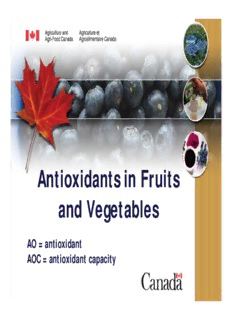
Kalt antioxidant workshop - AISA-AHIF PDF
Preview Kalt antioxidant workshop - AISA-AHIF
Antioxidants in Fruits and Vegetables AO = antioxidant AOC = antioxidant capacity Fruit, Vegetables & Health Fruit & vegetable consumption reduces disease risk HOW? • Essential vitamins & minerals • Fiber • Phytochemicals •Carotenoids •Polyphenols Antioxidants •Tocopherols •Ascorbate •Isothiocyanates Fruit & Vegetable Antioxidants (cid:131)Certain cancers (cid:131)Block et al.1992; Steinmetz & Potter 1996 (cid:131)Cardiovascular Disease (cid:131)Hertog et al. 1993; Joshipura et al. 1999 (cid:131)Neurodegenerative disease (cid:131)Kang JH et al. 2005 “...the protection provided against diseases by fruits and vegetables has been attributed to the various antioxidants contained in these foods.” (Ames et al., 1993) Oxidative Stress in Disease & Aging • Accumulation of deleterious changes to biological molecules • Change/damage to DNA, lipids, protein • Leading to disease & aging • Due to Oxidative Stress • Need for biomarkers of oxidative damage linked to disease The Antioxidant ‘Arms Race’ (Antioxidant capacities per gram of fresh wt.) Blueberry Blackberry Garlic Kale Strawberry Spinach Brussel Sprouts Plum Oxygen Radical Alfalfa Sprouts Absorption Capacity Broccoli Floret ORACROO (Fmol Trolox equiv. per gram) 0 5 10 15 20 25 Source: 1997 Research at the Jean Mayer USDA Human Nutrition Research Center on Aging, on the antioxidant characteristics of various fruits and vegetables. Journal of Agricultural and Food Chemistry 44:701-705; 3426-3343 Antioxidant Research at AAFC • Use existing tools to create an inventory of AAFC antioxidant research* • Survey antioxidant activity in vitro – Cell-based and non cell-based assays • Chemical profiling – Correlate chemical composition with AOC • Determine impact of production & processing on AO compounds and AOC • Animal and clinical studies FAO’s AgroVoc * http://www.fao.org/agrovoc F&V AO Research For each phytochemical AO consider… • Genetic variation (within & among species) • Tissue distribution (e.g. seeds, peels) • Environmental factors (e.g. light, water, disease) • Effect of maturity (e.g. green vs. ripe red fruit) • Removal and degradation during processing & storage (e.g. waste products, oxidation) • Impact of complex food matrix • Multiple forms (e.g. isomers, esters) • Antioxidant capacity of in vivo metabolites Polyphenolic Antioxidants How well are polyphenol AO absorbed? proanthocyanidin dimers anthocyanidins EGCG EGC EC rutin quercetin glucoside naringin hesperidin genistin daidzin 0 0.5 1 1.5 2 2.5 C max (uM) Adapted from Manach et al. 2005 AJCN & Williamson 2006 Experimental Biology maximum plasma concentration Serum Antioxidants Source: Wikipedia Antioxidant metabolite Solubility Human Serum (μM) Ascorbic acid (vitamin C) Water 50 – 60 Glutathione Water 4 Lipoic acid Water 0.1 – 0.7 Uric acid Water 200 – 400 β-carotene: 0.5 – 1 Carotenes Lipid retinol (vitamin A): 1 – 3 α-Tocopherol (vitamin E) Lipid 10 – 40 Ubiquinol (coenzyme Q) Lipid 5 versus transient serum polyphenol Cmax of about 0.02 – 2.0 μM
Description: